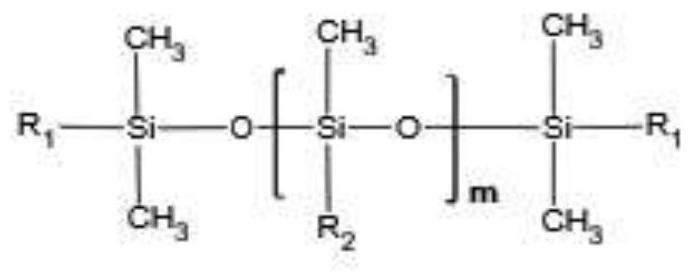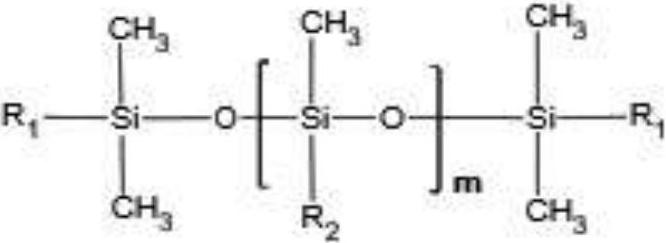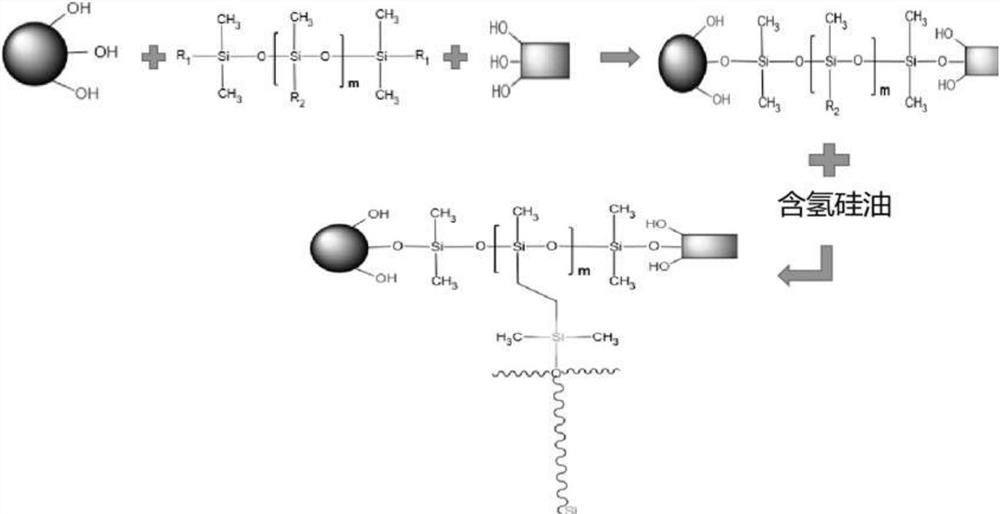Heat-conducting filler and anti-aging organic silicon heat-conducting gel prepared from heat-conducting filler
A heat-conducting filler and gel technology, which is applied in the field of aging-resistant silicone heat-conducting gels, can solve problems such as hardness climbing, precipitation of silicone oil, and decrease in flexibility, affecting heat conduction and heat dissipation performance, so as to reduce oil separation and improve high-temperature aging resistance The effect of low performance and hardness climb
- Summary
- Abstract
- Description
- Claims
- Application Information
AI Technical Summary
Problems solved by technology
Method used
Image
Examples
Embodiment 1
[0030] Step 1: Dissolve the silane modifier DA30 (Ambia Special Silicon Co., Ltd., with hydroxyl groups at both ends and methyl and vinyl branches in the branch chain) in acetone to make a modifier solution; the aluminum oxide and graphene oxide The ratio is 6:4, and the alumina and graphene oxide fillers are weighed and added to a sand mill for dispersion.
[0031] Step 2: Transfer the uniformly dispersed mixed filler to the reactor, raise the temperature to 90°C with stirring, preheat for 20 minutes, spray the silane modifier solution into the filler under stirring, and control the injection rate at 70g / min.
[0032] Step 3: keep stirring for 1 hour, add 30% methyltrimethoxysilane toluene solution, complete the reaction, cool to room temperature, transfer the filler to a 120°C oven and bake for 2 hours to obtain a thermally conductive filler.
Embodiment 2
[0033] Example 2: Thermally conductive filler prepared by using KH560 silane modifier.
[0034] Step 1: Dissolve KH560 (γ-glycidyl etheroxypropyltrimethoxysilane) in acetone to make a modifier solution; the ratio of alumina to graphene oxide is 6:4, weigh alumina and oxide Graphene filler is added into a sand mill for dispersion.
[0035] Step 2: Transfer the uniformly dispersed mixed filler to the reactor, raise the temperature to 90°C with stirring, preheat for 20 minutes, spray the silane modifier solution into the filler under stirring, and control the injection rate at 70g / min.
[0036] Step 3: keep stirring for 1 hour, add 30% methyltrimethoxysilane toluene solution, complete the reaction, cool to room temperature, transfer the filler to a 120°C oven and bake for 2 hours to obtain a thermally conductive filler.
Embodiment 3
[0037] Example 3: Alumina and graphene oxide were compounded at a ratio of 5:5 to obtain a thermally conductive filler.
[0038] Step 1: Dissolve DA20 (Ambia Special Silicon Co., Ltd., with alkoxy groups at both ends and methyl and vinyl branches in the branch chain) in acetone to make a modifier solution; the ratio of alumina to graphene oxide is 5:5, weigh alumina and graphene oxide fillers, add them into a sand mill for dispersion.
[0039] Step 2: Transfer the uniformly dispersed mixed filler to the reactor, raise the temperature to 90°C with stirring, preheat for 20 minutes, spray the silane modifier solution into the filler under stirring, and control the injection rate at 70g / min.
[0040] Step 3: keep stirring for 1 hour, add 30% methyltrimethoxysilane toluene solution, complete the reaction, cool to room temperature, transfer the filler to a 120°C oven and bake for 2 hours to obtain a thermally conductive filler.
PUM
 Login to View More
Login to View More Abstract
Description
Claims
Application Information
 Login to View More
Login to View More - R&D
- Intellectual Property
- Life Sciences
- Materials
- Tech Scout
- Unparalleled Data Quality
- Higher Quality Content
- 60% Fewer Hallucinations
Browse by: Latest US Patents, China's latest patents, Technical Efficacy Thesaurus, Application Domain, Technology Topic, Popular Technical Reports.
© 2025 PatSnap. All rights reserved.Legal|Privacy policy|Modern Slavery Act Transparency Statement|Sitemap|About US| Contact US: help@patsnap.com



